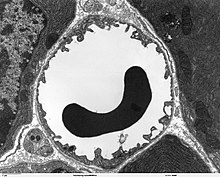Microcirculation
| Microcirculation | |
|---|---|
 Microcirculation in the capillary | |
| Details | |
| System | Circulatory system |
| Artery | Arteriole |
| Vein | Venule |
| Identifiers | |
| MeSH | D008833 |
| Anatomical terminology | |
The microcirculation is the
In addition to these blood vessels, the microcirculation also includes
Most vessels of the microcirculation are lined by flattened cells of the
The microcirculation contrasts with macrocirculation, which is the circulation of blood to and from the organs.
Structure
Microvessels


The vessels on the arterial side of the microcirculation are called the
The microcirculation has three major components: pre-capillary, capillary, and post-capillary. In the pre-capillary sector, arterioles, and
Microanatomy
Most vessels of the microcirculation are lined by flattened cells of the
Function
In addition to these blood vessels, the microcirculation also includes
Regulation
The regulation of tissue
Arterioles respond to metabolic stimuli that are generated in the tissues. When tissue metabolism increases,
Capillary exchange
The term capillary exchange refers to all exchanges at microcirculatory level, most of which occurs in the capillaries. Sites where material exchange occurs between the blood and tissues are the capillaries, which branch out to increase the swap area, minimize the diffusion distance as well as maximize the surface area and the exchange time.[4]
Approximately, seven percent of the body's blood is in the capillaries which continuously exchange substances with the liquid outside these blood vessels, called interstitial fluid. This dynamic displacement of materials between the interstitial fluid and the blood is named capillary exchange.[5] These substances pass through capillaries through three different systems or mechanisms: diffusion, bulk flow, and transcytosis or vesicular transport.[3] The liquid and solid exchanges that take place in the microvasculature particularly involve capillaries and post-capillary venules and collecting venules.[citation needed]
Capillary walls allow the free flow of almost every substance in plasma.[6] The plasma proteins are the only exception, as they are too big to pass through.[5] The minimum number of un-absorbable plasma proteins that exit capillaries enter lymphatic circulation for returning later on to those blood vessels. Those proteins which leave capillaries use the first capillary exchange mechanism and the process of diffusion, which is caused by kinetic motion of molecules.[6]
Regulation
These exchanges of substances are regulated by different mechanisms.[7] These mechanisms work together and promote capillary exchange in the following way. First, molecules that diffuse are going to travel a short distance thanks to the capillary wall, the small diameter and the close proximity to each cell having a capillary. The short distance is important because the capillary diffusion rate decreases when the diffusion distance increases. Then, because of its large number (10-14 million capillaries), there is an incredible amount of surface area for exchange. However, this only has 5% of the total blood volume (250 ml 5000 ml). Finally, blood flows more slowly in the capillaries, given the extensive branching.[4]
Diffusion
Bulk flow
The second mechanism of capillary exchange is
Transcytosis
The third capillary exchange mechanism is transcytosis, also called vesicular transport.[13] By this process, blood substances move across the endothelial cells that compose the capillary structure. Finally, these materials exit by exocytosis, the process by which vesicles go out from a cell to the interstitial space. Few substances cross by transcytosis: it is mainly used by large, lipid-insoluble molecules such as the insulin hormone.[14] Once vesicles exit the capillaries, they go to the interstitium.[14] Vesicles can go directly to a specific tissue or they can merge with other vesicles, so their contents are mixed. This intermixed material increases the functional capability of the vesicle.[5]
See also
- Fahraeus–Lindquist effect
- Glycocalyx
- Microcirculatory Society
References
- ^ ISBN 978-970-10-7341-4.[page needed]
- ISBN 8847011515. Retrieved 1 March 2023.
- ^ a b c Drucker, René. Medical physiology (1st ed.). Modern Manual. p. 137.
- ^ ISBN 970-729-069-2.
- ^ ISBN 978-0470565100.
- ^ ISBN 978-84-8086-819-8.
- ^ ISBN 9781451113846.
- ISBN 978-0123875846.
- PMID 6995154.
- ^ "Fluid Physiology: 4.1 Microcirculation".
- ISBN 9781615040667.
- ISBN 978-3-13-144061-7.
- ISBN 978-0071780032.
- ^ ISBN 978-0-7234-3388-0.
